A Comprehensive Analysis of Unilever's Business and Global Strategy
VerifiedAdded on 2023/06/15
|18
|6360
|116
Report
AI Summary
This report provides a critical analysis of Unilever's business strategy, examining its external environment through PESTLE and Porter's Five Forces, strategic capabilities using the VRIO framework, and business strategies. It addresses issues such as political factors, sustainability initiatives, and international strategy. The analysis includes a business model canvas and concludes with strategic options for Unilever to maintain or enhance its competitiveness in the future, considering the impacts of macro and competitive forces. The report emphasizes the importance of adapting to market changes and consumer demands through a strong distribution network, intellectual property, and a diverse brand portfolio.
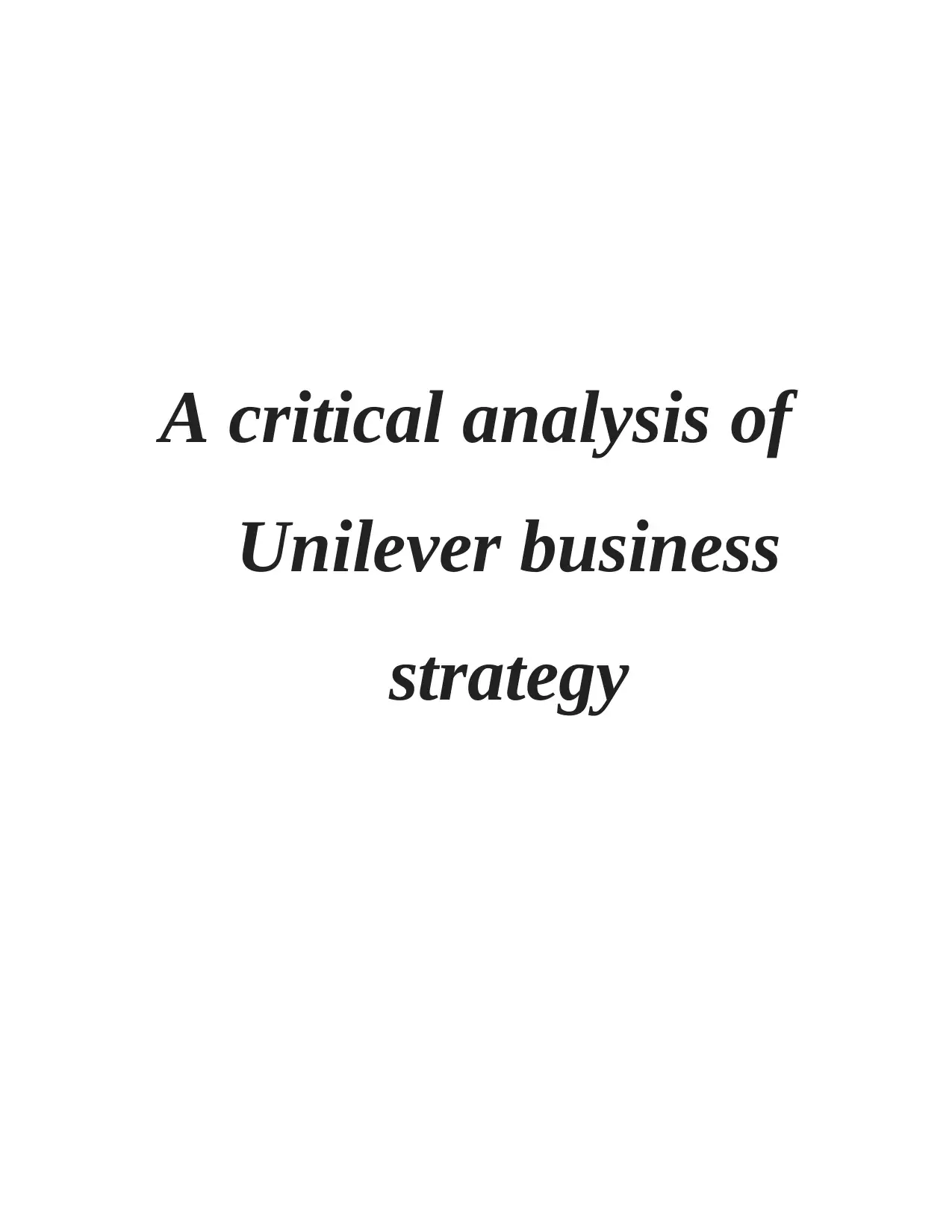
A critical analysis of
Unilever business
strategy
Unilever business
strategy
Paraphrase This Document
Need a fresh take? Get an instant paraphrase of this document with our AI Paraphraser
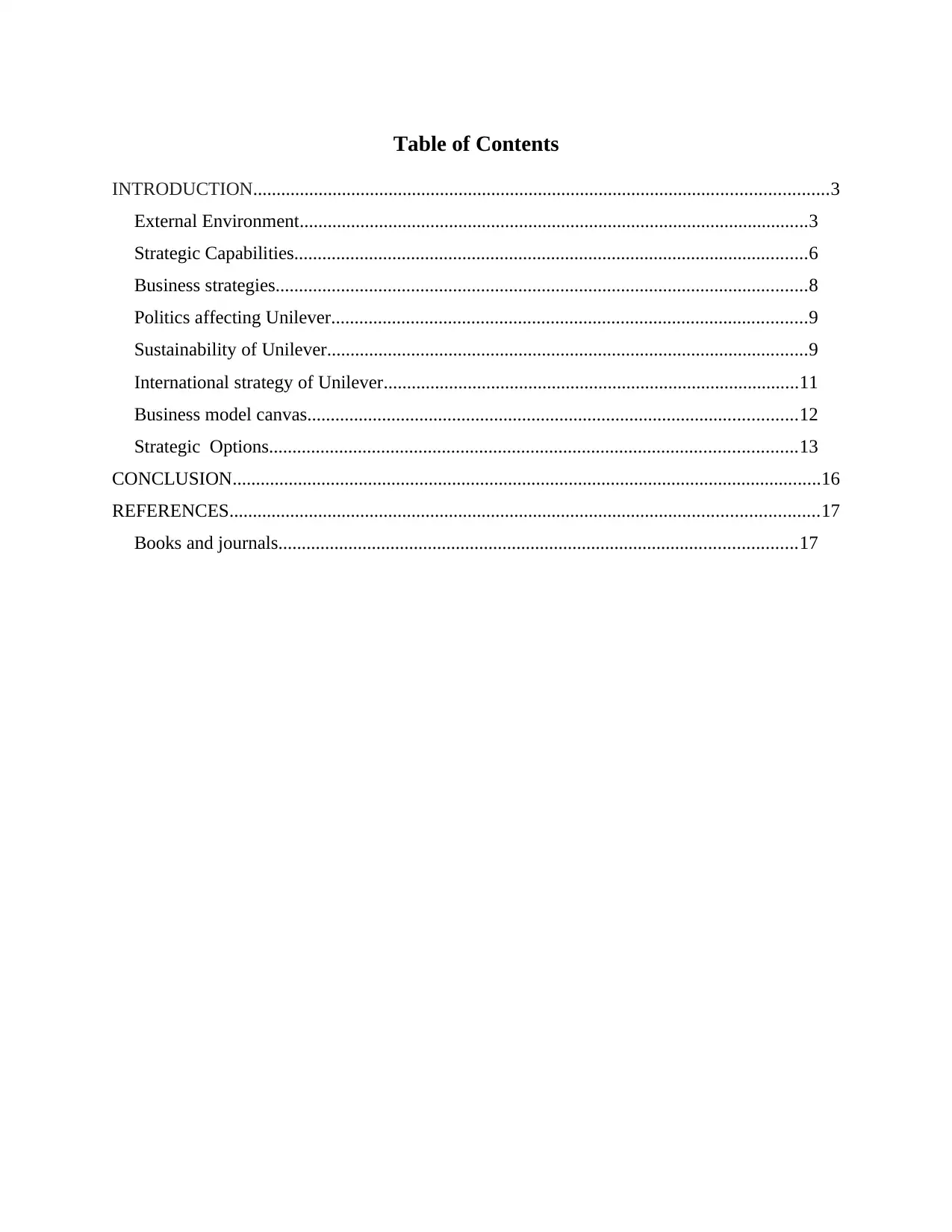
Table of Contents
INTRODUCTION...........................................................................................................................3
External Environment.............................................................................................................3
Strategic Capabilities..............................................................................................................6
Business strategies..................................................................................................................8
Politics affecting Unilever......................................................................................................9
Sustainability of Unilever.......................................................................................................9
International strategy of Unilever.........................................................................................11
Business model canvas.........................................................................................................12
Strategic Options.................................................................................................................13
CONCLUSION..............................................................................................................................16
REFERENCES..............................................................................................................................17
Books and journals...............................................................................................................17
INTRODUCTION...........................................................................................................................3
External Environment.............................................................................................................3
Strategic Capabilities..............................................................................................................6
Business strategies..................................................................................................................8
Politics affecting Unilever......................................................................................................9
Sustainability of Unilever.......................................................................................................9
International strategy of Unilever.........................................................................................11
Business model canvas.........................................................................................................12
Strategic Options.................................................................................................................13
CONCLUSION..............................................................................................................................16
REFERENCES..............................................................................................................................17
Books and journals...............................................................................................................17

INTRODUCTION
A business strategy is a set of competitor changes and activities that an enterprise utilise
to captivate consumers, to take part with success, increasing the presentation, and accomplishing
the objectives of a company. It figure out the way an enterprise should be carried out to extend
the desirable points. A business strategy makes an imagination and path for the overall firm. It is
essential that every individual in a firm have clarity of objectives and are pursuing the path, or
aim of the firm (Villena and Dhanorkar, 2020). Unilever is taken as the base company which is a
British multinational customer commodities firm founded in 1929. This firm serves as home care
products, Beauty and personal care and also food, refreshments to the different parts of the
world. This file covers analysing of external environment by using PESTLE and Porter's five
forces, strategical abilities and corporate strategies used by the firm. This will also cover some
issues of politics, sustainability or business models and strategical options for the firm to
improve competition in the future.
External Environment
PESTLE Analysis
This factor is connected to governing body which may affect a firm or an management. This
component is forever at the danger of being targeted by the system of rules as it has its personal
priority that is safety of the people. The authorities will prohibit the company if it does not
connected with risk and wellness incidental to regularisations. In case of Unilever, firm is
capable to the regulative limitation and road map noticed by the European Committee and the
Food and Drug management the United States of America (Waghmare and Golhar, 2017). If they
were not capable to follow, the firm would face lawful problems that is civic and criminal and
risk fines. Unilever is likely to all localised and regional laws and international rules set in every
state where the commodities of the firm are distributed.
Economical:
This factor has a vast affect on economic condition of a company either growth or declining,
extended opportunities in the market. If economic situation is changing, then no doubt it will
affect rightly or accidentally to the organisation. In context to Unilever, can utilise country’s
economical constituents like development rate, rising prices & firm's economical signals like
A business strategy is a set of competitor changes and activities that an enterprise utilise
to captivate consumers, to take part with success, increasing the presentation, and accomplishing
the objectives of a company. It figure out the way an enterprise should be carried out to extend
the desirable points. A business strategy makes an imagination and path for the overall firm. It is
essential that every individual in a firm have clarity of objectives and are pursuing the path, or
aim of the firm (Villena and Dhanorkar, 2020). Unilever is taken as the base company which is a
British multinational customer commodities firm founded in 1929. This firm serves as home care
products, Beauty and personal care and also food, refreshments to the different parts of the
world. This file covers analysing of external environment by using PESTLE and Porter's five
forces, strategical abilities and corporate strategies used by the firm. This will also cover some
issues of politics, sustainability or business models and strategical options for the firm to
improve competition in the future.
External Environment
PESTLE Analysis
This factor is connected to governing body which may affect a firm or an management. This
component is forever at the danger of being targeted by the system of rules as it has its personal
priority that is safety of the people. The authorities will prohibit the company if it does not
connected with risk and wellness incidental to regularisations. In case of Unilever, firm is
capable to the regulative limitation and road map noticed by the European Committee and the
Food and Drug management the United States of America (Waghmare and Golhar, 2017). If they
were not capable to follow, the firm would face lawful problems that is civic and criminal and
risk fines. Unilever is likely to all localised and regional laws and international rules set in every
state where the commodities of the firm are distributed.
Economical:
This factor has a vast affect on economic condition of a company either growth or declining,
extended opportunities in the market. If economic situation is changing, then no doubt it will
affect rightly or accidentally to the organisation. In context to Unilever, can utilise country’s
economical constituents like development rate, rising prices & firm's economical signals like
⊘ This is a preview!⊘
Do you want full access?
Subscribe today to unlock all pages.

Trusted by 1+ million students worldwide
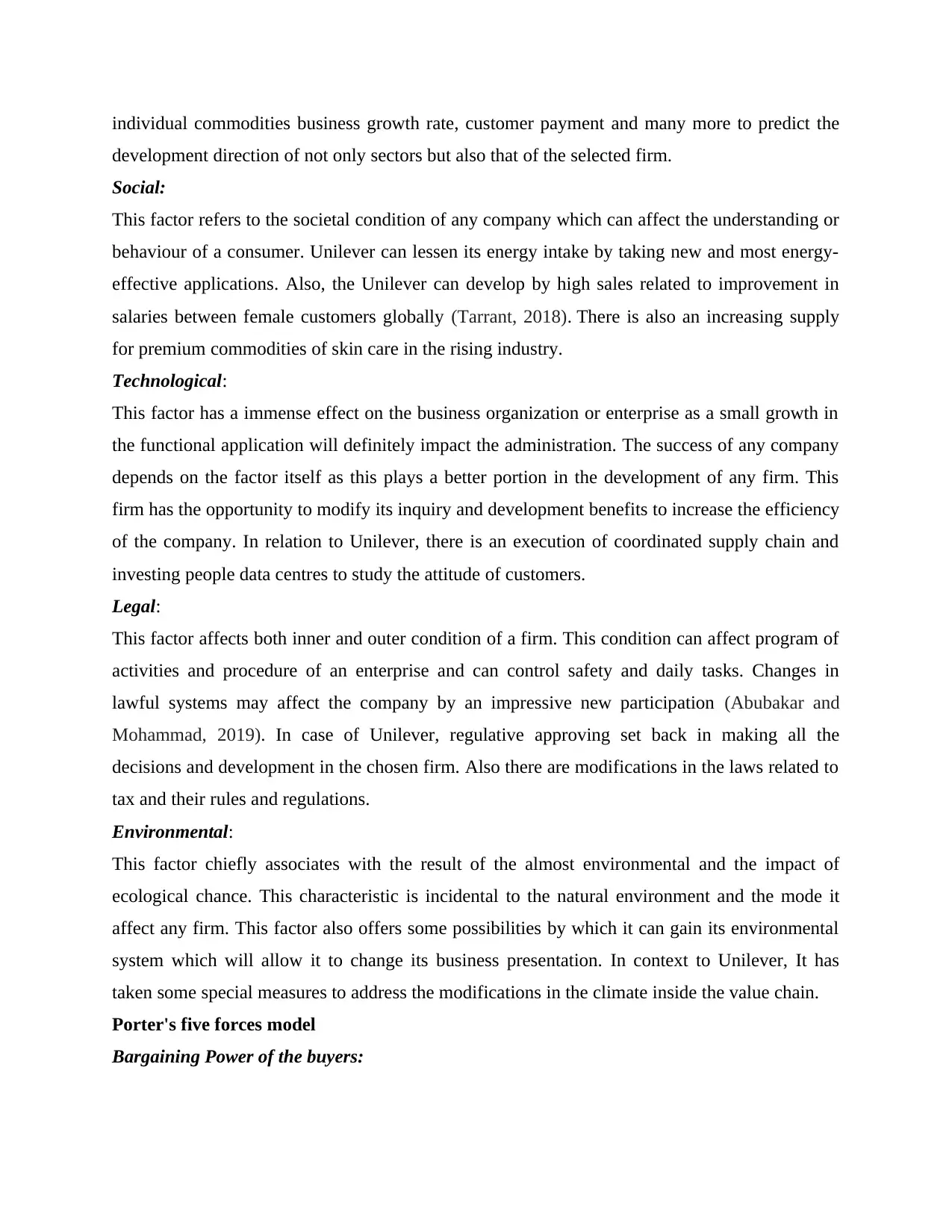
individual commodities business growth rate, customer payment and many more to predict the
development direction of not only sectors but also that of the selected firm.
Social:
This factor refers to the societal condition of any company which can affect the understanding or
behaviour of a consumer. Unilever can lessen its energy intake by taking new and most energy-
effective applications. Also, the Unilever can develop by high sales related to improvement in
salaries between female customers globally (Tarrant, 2018). There is also an increasing supply
for premium commodities of skin care in the rising industry.
Technological:
This factor has a immense effect on the business organization or enterprise as a small growth in
the functional application will definitely impact the administration. The success of any company
depends on the factor itself as this plays a better portion in the development of any firm. This
firm has the opportunity to modify its inquiry and development benefits to increase the efficiency
of the company. In relation to Unilever, there is an execution of coordinated supply chain and
investing people data centres to study the attitude of customers.
Legal:
This factor affects both inner and outer condition of a firm. This condition can affect program of
activities and procedure of an enterprise and can control safety and daily tasks. Changes in
lawful systems may affect the company by an impressive new participation (Abubakar and
Mohammad, 2019). In case of Unilever, regulative approving set back in making all the
decisions and development in the chosen firm. Also there are modifications in the laws related to
tax and their rules and regulations.
Environmental:
This factor chiefly associates with the result of the almost environmental and the impact of
ecological chance. This characteristic is incidental to the natural environment and the mode it
affect any firm. This factor also offers some possibilities by which it can gain its environmental
system which will allow it to change its business presentation. In context to Unilever, It has
taken some special measures to address the modifications in the climate inside the value chain.
Porter's five forces model
Bargaining Power of the buyers:
development direction of not only sectors but also that of the selected firm.
Social:
This factor refers to the societal condition of any company which can affect the understanding or
behaviour of a consumer. Unilever can lessen its energy intake by taking new and most energy-
effective applications. Also, the Unilever can develop by high sales related to improvement in
salaries between female customers globally (Tarrant, 2018). There is also an increasing supply
for premium commodities of skin care in the rising industry.
Technological:
This factor has a immense effect on the business organization or enterprise as a small growth in
the functional application will definitely impact the administration. The success of any company
depends on the factor itself as this plays a better portion in the development of any firm. This
firm has the opportunity to modify its inquiry and development benefits to increase the efficiency
of the company. In relation to Unilever, there is an execution of coordinated supply chain and
investing people data centres to study the attitude of customers.
Legal:
This factor affects both inner and outer condition of a firm. This condition can affect program of
activities and procedure of an enterprise and can control safety and daily tasks. Changes in
lawful systems may affect the company by an impressive new participation (Abubakar and
Mohammad, 2019). In case of Unilever, regulative approving set back in making all the
decisions and development in the chosen firm. Also there are modifications in the laws related to
tax and their rules and regulations.
Environmental:
This factor chiefly associates with the result of the almost environmental and the impact of
ecological chance. This characteristic is incidental to the natural environment and the mode it
affect any firm. This factor also offers some possibilities by which it can gain its environmental
system which will allow it to change its business presentation. In context to Unilever, It has
taken some special measures to address the modifications in the climate inside the value chain.
Porter's five forces model
Bargaining Power of the buyers:
Paraphrase This Document
Need a fresh take? Get an instant paraphrase of this document with our AI Paraphraser
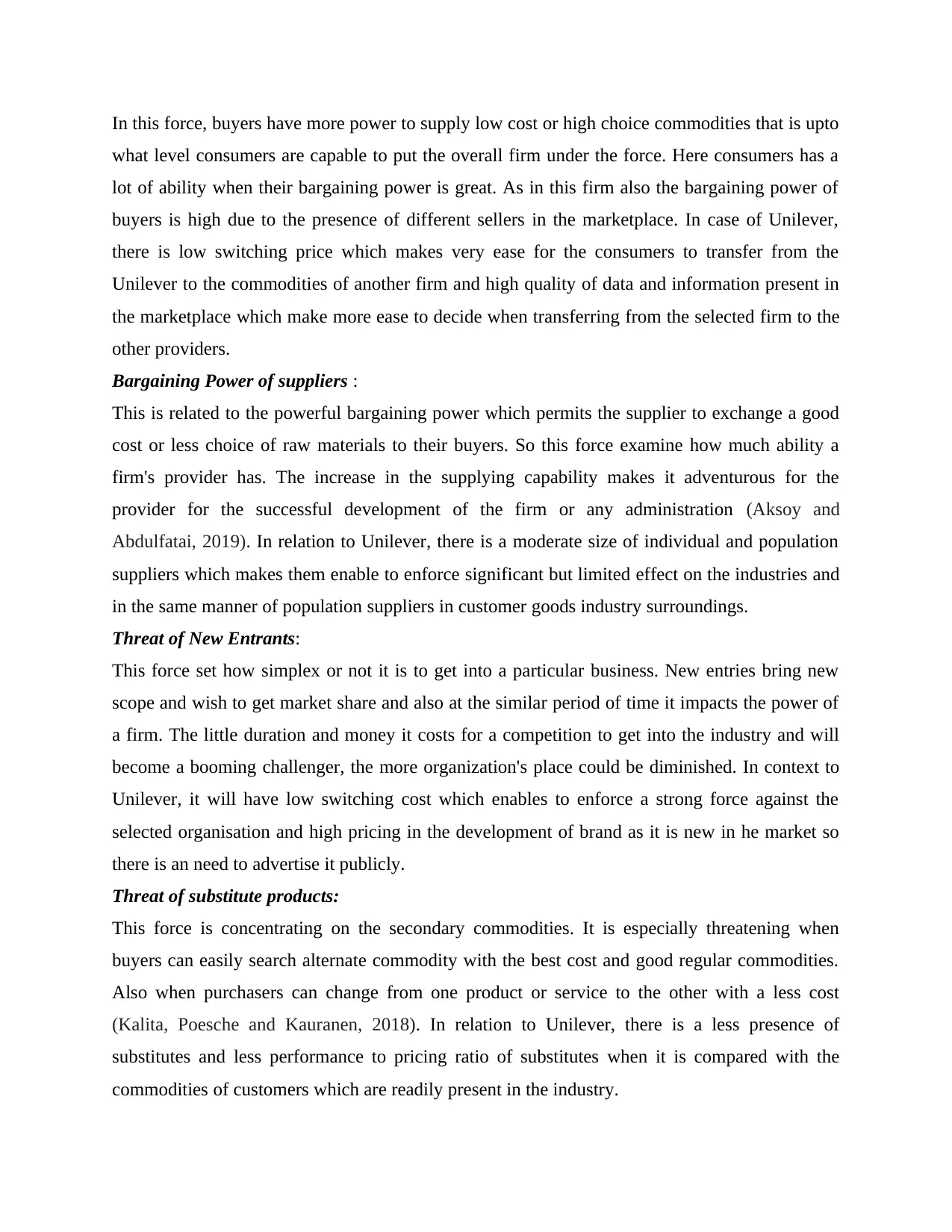
In this force, buyers have more power to supply low cost or high choice commodities that is upto
what level consumers are capable to put the overall firm under the force. Here consumers has a
lot of ability when their bargaining power is great. As in this firm also the bargaining power of
buyers is high due to the presence of different sellers in the marketplace. In case of Unilever,
there is low switching price which makes very ease for the consumers to transfer from the
Unilever to the commodities of another firm and high quality of data and information present in
the marketplace which make more ease to decide when transferring from the selected firm to the
other providers.
Bargaining Power of suppliers :
This is related to the powerful bargaining power which permits the supplier to exchange a good
cost or less choice of raw materials to their buyers. So this force examine how much ability a
firm's provider has. The increase in the supplying capability makes it adventurous for the
provider for the successful development of the firm or any administration (Aksoy and
Abdulfatai, 2019). In relation to Unilever, there is a moderate size of individual and population
suppliers which makes them enable to enforce significant but limited effect on the industries and
in the same manner of population suppliers in customer goods industry surroundings.
Threat of New Entrants:
This force set how simplex or not it is to get into a particular business. New entries bring new
scope and wish to get market share and also at the similar period of time it impacts the power of
a firm. The little duration and money it costs for a competition to get into the industry and will
become a booming challenger, the more organization's place could be diminished. In context to
Unilever, it will have low switching cost which enables to enforce a strong force against the
selected organisation and high pricing in the development of brand as it is new in he market so
there is an need to advertise it publicly.
Threat of substitute products:
This force is concentrating on the secondary commodities. It is especially threatening when
buyers can easily search alternate commodity with the best cost and good regular commodities.
Also when purchasers can change from one product or service to the other with a less cost
(Kalita, Poesche and Kauranen, 2018). In relation to Unilever, there is a less presence of
substitutes and less performance to pricing ratio of substitutes when it is compared with the
commodities of customers which are readily present in the industry.
what level consumers are capable to put the overall firm under the force. Here consumers has a
lot of ability when their bargaining power is great. As in this firm also the bargaining power of
buyers is high due to the presence of different sellers in the marketplace. In case of Unilever,
there is low switching price which makes very ease for the consumers to transfer from the
Unilever to the commodities of another firm and high quality of data and information present in
the marketplace which make more ease to decide when transferring from the selected firm to the
other providers.
Bargaining Power of suppliers :
This is related to the powerful bargaining power which permits the supplier to exchange a good
cost or less choice of raw materials to their buyers. So this force examine how much ability a
firm's provider has. The increase in the supplying capability makes it adventurous for the
provider for the successful development of the firm or any administration (Aksoy and
Abdulfatai, 2019). In relation to Unilever, there is a moderate size of individual and population
suppliers which makes them enable to enforce significant but limited effect on the industries and
in the same manner of population suppliers in customer goods industry surroundings.
Threat of New Entrants:
This force set how simplex or not it is to get into a particular business. New entries bring new
scope and wish to get market share and also at the similar period of time it impacts the power of
a firm. The little duration and money it costs for a competition to get into the industry and will
become a booming challenger, the more organization's place could be diminished. In context to
Unilever, it will have low switching cost which enables to enforce a strong force against the
selected organisation and high pricing in the development of brand as it is new in he market so
there is an need to advertise it publicly.
Threat of substitute products:
This force is concentrating on the secondary commodities. It is especially threatening when
buyers can easily search alternate commodity with the best cost and good regular commodities.
Also when purchasers can change from one product or service to the other with a less cost
(Kalita, Poesche and Kauranen, 2018). In relation to Unilever, there is a less presence of
substitutes and less performance to pricing ratio of substitutes when it is compared with the
commodities of customers which are readily present in the industry.
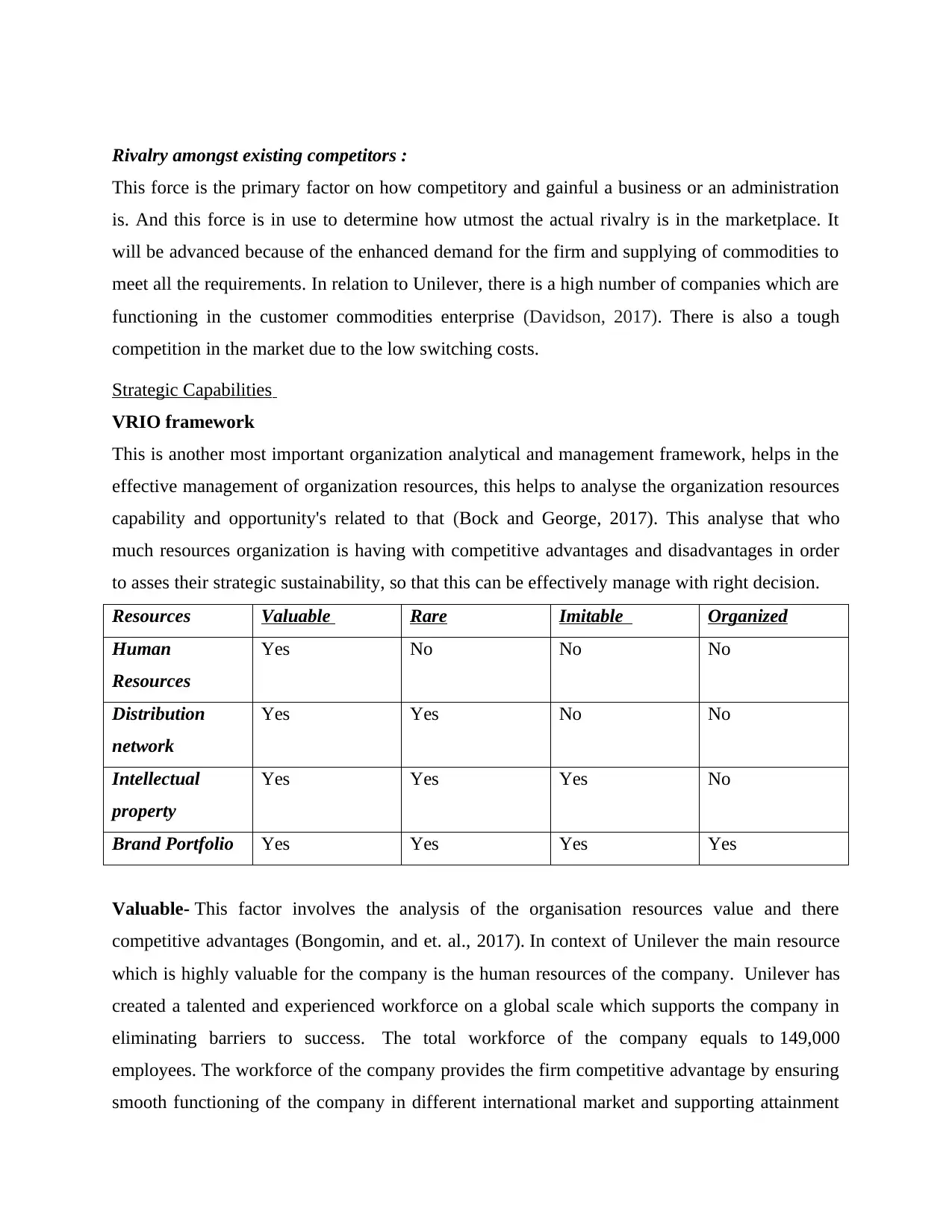
Rivalry amongst existing competitors :
This force is the primary factor on how competitory and gainful a business or an administration
is. And this force is in use to determine how utmost the actual rivalry is in the marketplace. It
will be advanced because of the enhanced demand for the firm and supplying of commodities to
meet all the requirements. In relation to Unilever, there is a high number of companies which are
functioning in the customer commodities enterprise (Davidson, 2017). There is also a tough
competition in the market due to the low switching costs.
Strategic Capabilities
VRIO framework
This is another most important organization analytical and management framework, helps in the
effective management of organization resources, this helps to analyse the organization resources
capability and opportunity's related to that (Bock and George, 2017). This analyse that who
much resources organization is having with competitive advantages and disadvantages in order
to asses their strategic sustainability, so that this can be effectively manage with right decision.
Resources Valuable Rare Imitable Organized
Human
Resources
Yes No No No
Distribution
network
Yes Yes No No
Intellectual
property
Yes Yes Yes No
Brand Portfolio Yes Yes Yes Yes
Valuable- This factor involves the analysis of the organisation resources value and there
competitive advantages (Bongomin, and et. al., 2017). In context of Unilever the main resource
which is highly valuable for the company is the human resources of the company. Unilever has
created a talented and experienced workforce on a global scale which supports the company in
eliminating barriers to success. The total workforce of the company equals to 149,000
employees. The workforce of the company provides the firm competitive advantage by ensuring
smooth functioning of the company in different international market and supporting attainment
This force is the primary factor on how competitory and gainful a business or an administration
is. And this force is in use to determine how utmost the actual rivalry is in the marketplace. It
will be advanced because of the enhanced demand for the firm and supplying of commodities to
meet all the requirements. In relation to Unilever, there is a high number of companies which are
functioning in the customer commodities enterprise (Davidson, 2017). There is also a tough
competition in the market due to the low switching costs.
Strategic Capabilities
VRIO framework
This is another most important organization analytical and management framework, helps in the
effective management of organization resources, this helps to analyse the organization resources
capability and opportunity's related to that (Bock and George, 2017). This analyse that who
much resources organization is having with competitive advantages and disadvantages in order
to asses their strategic sustainability, so that this can be effectively manage with right decision.
Resources Valuable Rare Imitable Organized
Human
Resources
Yes No No No
Distribution
network
Yes Yes No No
Intellectual
property
Yes Yes Yes No
Brand Portfolio Yes Yes Yes Yes
Valuable- This factor involves the analysis of the organisation resources value and there
competitive advantages (Bongomin, and et. al., 2017). In context of Unilever the main resource
which is highly valuable for the company is the human resources of the company. Unilever has
created a talented and experienced workforce on a global scale which supports the company in
eliminating barriers to success. The total workforce of the company equals to 149,000
employees. The workforce of the company provides the firm competitive advantage by ensuring
smooth functioning of the company in different international market and supporting attainment
⊘ This is a preview!⊘
Do you want full access?
Subscribe today to unlock all pages.

Trusted by 1+ million students worldwide

of business objectives in a timely manner. Another valuable resource which is present at
Unilever is the strong distribution network of the company. Unilever has been able to construct
a global distribution network which supports quick movement of goods across the globe. With
the help of such distribution network Unilever is able to quickly respond to market changes and
consumer demands. The company has built expertise in last mile distribution and providing
quick delivery to consumers across the globe. The intellectual property of Unilever is also a
valuable resource of the company because it consists of the innovations which help the
company solve consumers problem effectively and create a distinctive brand image in the
industry. After this, the brand portfolio of the company consisting of various global as well as
regional brands is the valuable resource of the company which enables Unilever to maintain
strong presence in different international markets.
Rare- This is another factor of the framework covers the analysis and management of the rare
competitive resources (Greeven and Wei, 2017). The distribution network established by
the Unilever is a rare resource held by the organisation because developing a global distribution
network is time consuming and requires heavy investment. Recently formed enterprises are not
able to will such strong distribution networks which make this resource rare. The intellectual
property of the organisation which consists of 20,000 patents is a rare resource because patents
cannot be easily gained and involve legal procedures to acquire an international patent
(Innovating boldly for people and planet, 2021). Finally the brand portfolio of in liver is real
because it consists of different established national and regional brands end developing such
huge portfolio requires huge financial investment and time.
Imitable- This involve the some important sates of the resources which are limited, effective,
competitive and cannot be achieve by the competitors easily (Kariv, Cisneros and Ibanescu,
2019). The patents gained by Unilever cannot be imitated easily because acquiring international
patient is a time consuming process which requires following different legal procedures. The
resource of gaining patents on different innovation has helped the company secure innovative
solutions on an international scale for thousands of innovative products which is not easy to
imitate. The brand portfolio of the company which consists of hundreds of different regional
international blends which are established effectively in different markets cannot be imitated
easily because acquiring and maintaining such brands on local and global level requires
marketing and financial effort along with huge time investment.
Unilever is the strong distribution network of the company. Unilever has been able to construct
a global distribution network which supports quick movement of goods across the globe. With
the help of such distribution network Unilever is able to quickly respond to market changes and
consumer demands. The company has built expertise in last mile distribution and providing
quick delivery to consumers across the globe. The intellectual property of Unilever is also a
valuable resource of the company because it consists of the innovations which help the
company solve consumers problem effectively and create a distinctive brand image in the
industry. After this, the brand portfolio of the company consisting of various global as well as
regional brands is the valuable resource of the company which enables Unilever to maintain
strong presence in different international markets.
Rare- This is another factor of the framework covers the analysis and management of the rare
competitive resources (Greeven and Wei, 2017). The distribution network established by
the Unilever is a rare resource held by the organisation because developing a global distribution
network is time consuming and requires heavy investment. Recently formed enterprises are not
able to will such strong distribution networks which make this resource rare. The intellectual
property of the organisation which consists of 20,000 patents is a rare resource because patents
cannot be easily gained and involve legal procedures to acquire an international patent
(Innovating boldly for people and planet, 2021). Finally the brand portfolio of in liver is real
because it consists of different established national and regional brands end developing such
huge portfolio requires huge financial investment and time.
Imitable- This involve the some important sates of the resources which are limited, effective,
competitive and cannot be achieve by the competitors easily (Kariv, Cisneros and Ibanescu,
2019). The patents gained by Unilever cannot be imitated easily because acquiring international
patient is a time consuming process which requires following different legal procedures. The
resource of gaining patents on different innovation has helped the company secure innovative
solutions on an international scale for thousands of innovative products which is not easy to
imitate. The brand portfolio of the company which consists of hundreds of different regional
international blends which are established effectively in different markets cannot be imitated
easily because acquiring and maintaining such brands on local and global level requires
marketing and financial effort along with huge time investment.
Paraphrase This Document
Need a fresh take? Get an instant paraphrase of this document with our AI Paraphraser
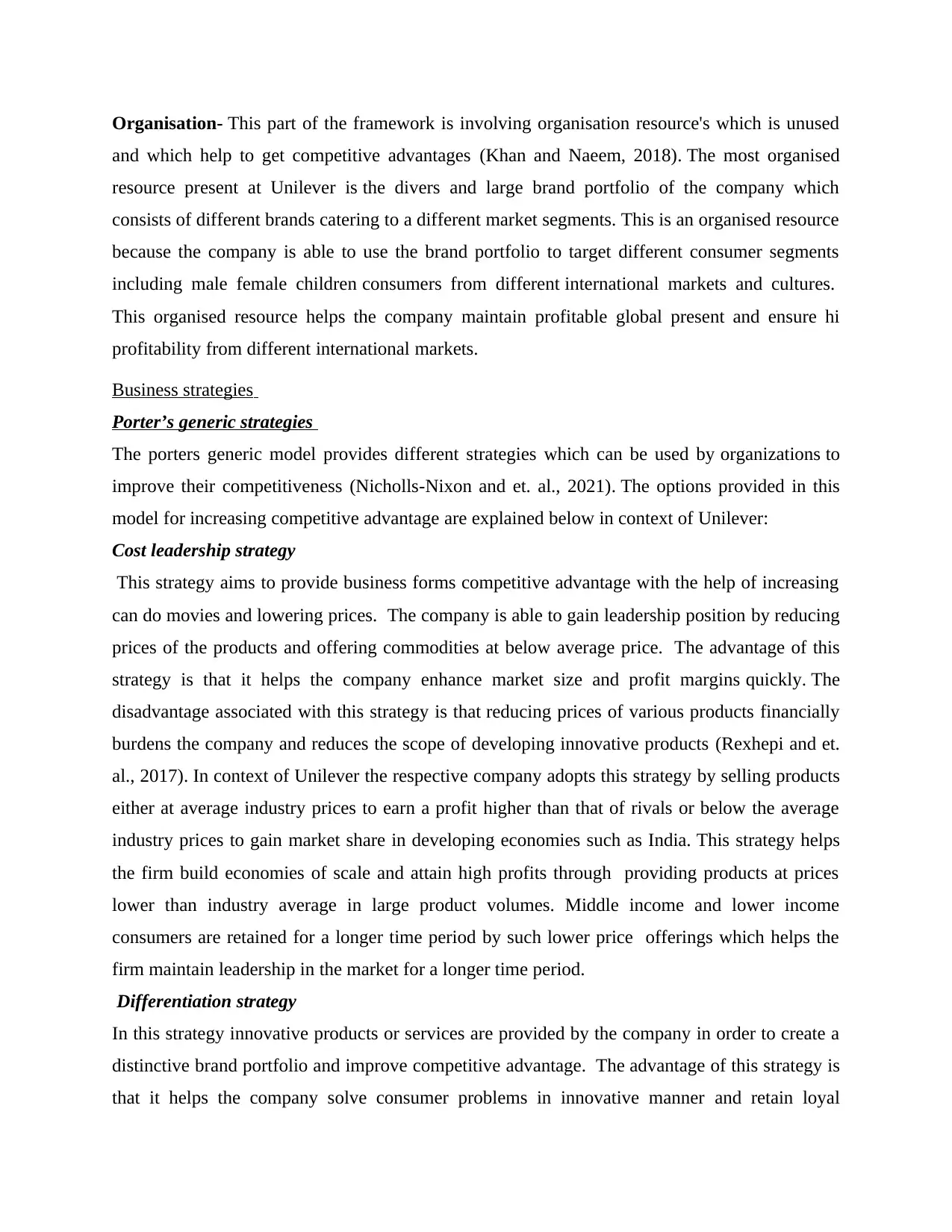
Organisation- This part of the framework is involving organisation resource's which is unused
and which help to get competitive advantages (Khan and Naeem, 2018). The most organised
resource present at Unilever is the divers and large brand portfolio of the company which
consists of different brands catering to a different market segments. This is an organised resource
because the company is able to use the brand portfolio to target different consumer segments
including male female children consumers from different international markets and cultures.
This organised resource helps the company maintain profitable global present and ensure hi
profitability from different international markets.
Business strategies
Porter’s generic strategies
The porters generic model provides different strategies which can be used by organizations to
improve their competitiveness (Nicholls-Nixon and et. al., 2021). The options provided in this
model for increasing competitive advantage are explained below in context of Unilever:
Cost leadership strategy
This strategy aims to provide business forms competitive advantage with the help of increasing
can do movies and lowering prices. The company is able to gain leadership position by reducing
prices of the products and offering commodities at below average price. The advantage of this
strategy is that it helps the company enhance market size and profit margins quickly. The
disadvantage associated with this strategy is that reducing prices of various products financially
burdens the company and reduces the scope of developing innovative products (Rexhepi and et.
al., 2017). In context of Unilever the respective company adopts this strategy by selling products
either at average industry prices to earn a profit higher than that of rivals or below the average
industry prices to gain market share in developing economies such as India. This strategy helps
the firm build economies of scale and attain high profits through providing products at prices
lower than industry average in large product volumes. Middle income and lower income
consumers are retained for a longer time period by such lower price offerings which helps the
firm maintain leadership in the market for a longer time period.
Differentiation strategy
In this strategy innovative products or services are provided by the company in order to create a
distinctive brand portfolio and improve competitive advantage. The advantage of this strategy is
that it helps the company solve consumer problems in innovative manner and retain loyal
and which help to get competitive advantages (Khan and Naeem, 2018). The most organised
resource present at Unilever is the divers and large brand portfolio of the company which
consists of different brands catering to a different market segments. This is an organised resource
because the company is able to use the brand portfolio to target different consumer segments
including male female children consumers from different international markets and cultures.
This organised resource helps the company maintain profitable global present and ensure hi
profitability from different international markets.
Business strategies
Porter’s generic strategies
The porters generic model provides different strategies which can be used by organizations to
improve their competitiveness (Nicholls-Nixon and et. al., 2021). The options provided in this
model for increasing competitive advantage are explained below in context of Unilever:
Cost leadership strategy
This strategy aims to provide business forms competitive advantage with the help of increasing
can do movies and lowering prices. The company is able to gain leadership position by reducing
prices of the products and offering commodities at below average price. The advantage of this
strategy is that it helps the company enhance market size and profit margins quickly. The
disadvantage associated with this strategy is that reducing prices of various products financially
burdens the company and reduces the scope of developing innovative products (Rexhepi and et.
al., 2017). In context of Unilever the respective company adopts this strategy by selling products
either at average industry prices to earn a profit higher than that of rivals or below the average
industry prices to gain market share in developing economies such as India. This strategy helps
the firm build economies of scale and attain high profits through providing products at prices
lower than industry average in large product volumes. Middle income and lower income
consumers are retained for a longer time period by such lower price offerings which helps the
firm maintain leadership in the market for a longer time period.
Differentiation strategy
In this strategy innovative products or services are provided by the company in order to create a
distinctive brand portfolio and improve competitive advantage. The advantage of this strategy is
that it helps the company solve consumer problems in innovative manner and retain loyal
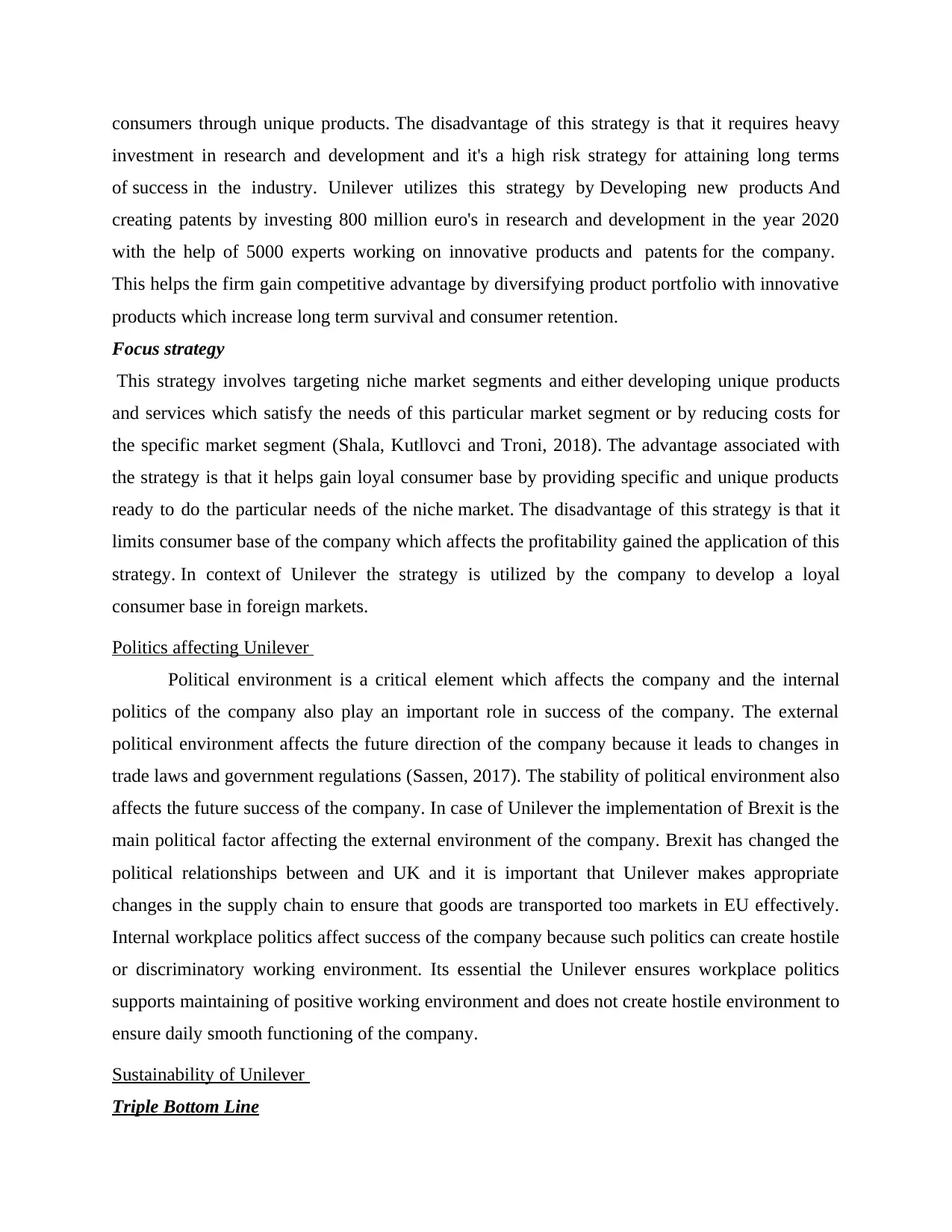
consumers through unique products. The disadvantage of this strategy is that it requires heavy
investment in research and development and it's a high risk strategy for attaining long terms
of success in the industry. Unilever utilizes this strategy by Developing new products And
creating patents by investing 800 million euro's in research and development in the year 2020
with the help of 5000 experts working on innovative products and patents for the company.
This helps the firm gain competitive advantage by diversifying product portfolio with innovative
products which increase long term survival and consumer retention.
Focus strategy
This strategy involves targeting niche market segments and either developing unique products
and services which satisfy the needs of this particular market segment or by reducing costs for
the specific market segment (Shala, Kutllovci and Troni, 2018). The advantage associated with
the strategy is that it helps gain loyal consumer base by providing specific and unique products
ready to do the particular needs of the niche market. The disadvantage of this strategy is that it
limits consumer base of the company which affects the profitability gained the application of this
strategy. In context of Unilever the strategy is utilized by the company to develop a loyal
consumer base in foreign markets.
Politics affecting Unilever
Political environment is a critical element which affects the company and the internal
politics of the company also play an important role in success of the company. The external
political environment affects the future direction of the company because it leads to changes in
trade laws and government regulations (Sassen, 2017). The stability of political environment also
affects the future success of the company. In case of Unilever the implementation of Brexit is the
main political factor affecting the external environment of the company. Brexit has changed the
political relationships between and UK and it is important that Unilever makes appropriate
changes in the supply chain to ensure that goods are transported too markets in EU effectively.
Internal workplace politics affect success of the company because such politics can create hostile
or discriminatory working environment. Its essential the Unilever ensures workplace politics
supports maintaining of positive working environment and does not create hostile environment to
ensure daily smooth functioning of the company.
Sustainability of Unilever
Triple Bottom Line
investment in research and development and it's a high risk strategy for attaining long terms
of success in the industry. Unilever utilizes this strategy by Developing new products And
creating patents by investing 800 million euro's in research and development in the year 2020
with the help of 5000 experts working on innovative products and patents for the company.
This helps the firm gain competitive advantage by diversifying product portfolio with innovative
products which increase long term survival and consumer retention.
Focus strategy
This strategy involves targeting niche market segments and either developing unique products
and services which satisfy the needs of this particular market segment or by reducing costs for
the specific market segment (Shala, Kutllovci and Troni, 2018). The advantage associated with
the strategy is that it helps gain loyal consumer base by providing specific and unique products
ready to do the particular needs of the niche market. The disadvantage of this strategy is that it
limits consumer base of the company which affects the profitability gained the application of this
strategy. In context of Unilever the strategy is utilized by the company to develop a loyal
consumer base in foreign markets.
Politics affecting Unilever
Political environment is a critical element which affects the company and the internal
politics of the company also play an important role in success of the company. The external
political environment affects the future direction of the company because it leads to changes in
trade laws and government regulations (Sassen, 2017). The stability of political environment also
affects the future success of the company. In case of Unilever the implementation of Brexit is the
main political factor affecting the external environment of the company. Brexit has changed the
political relationships between and UK and it is important that Unilever makes appropriate
changes in the supply chain to ensure that goods are transported too markets in EU effectively.
Internal workplace politics affect success of the company because such politics can create hostile
or discriminatory working environment. Its essential the Unilever ensures workplace politics
supports maintaining of positive working environment and does not create hostile environment to
ensure daily smooth functioning of the company.
Sustainability of Unilever
Triple Bottom Line
⊘ This is a preview!⊘
Do you want full access?
Subscribe today to unlock all pages.

Trusted by 1+ million students worldwide
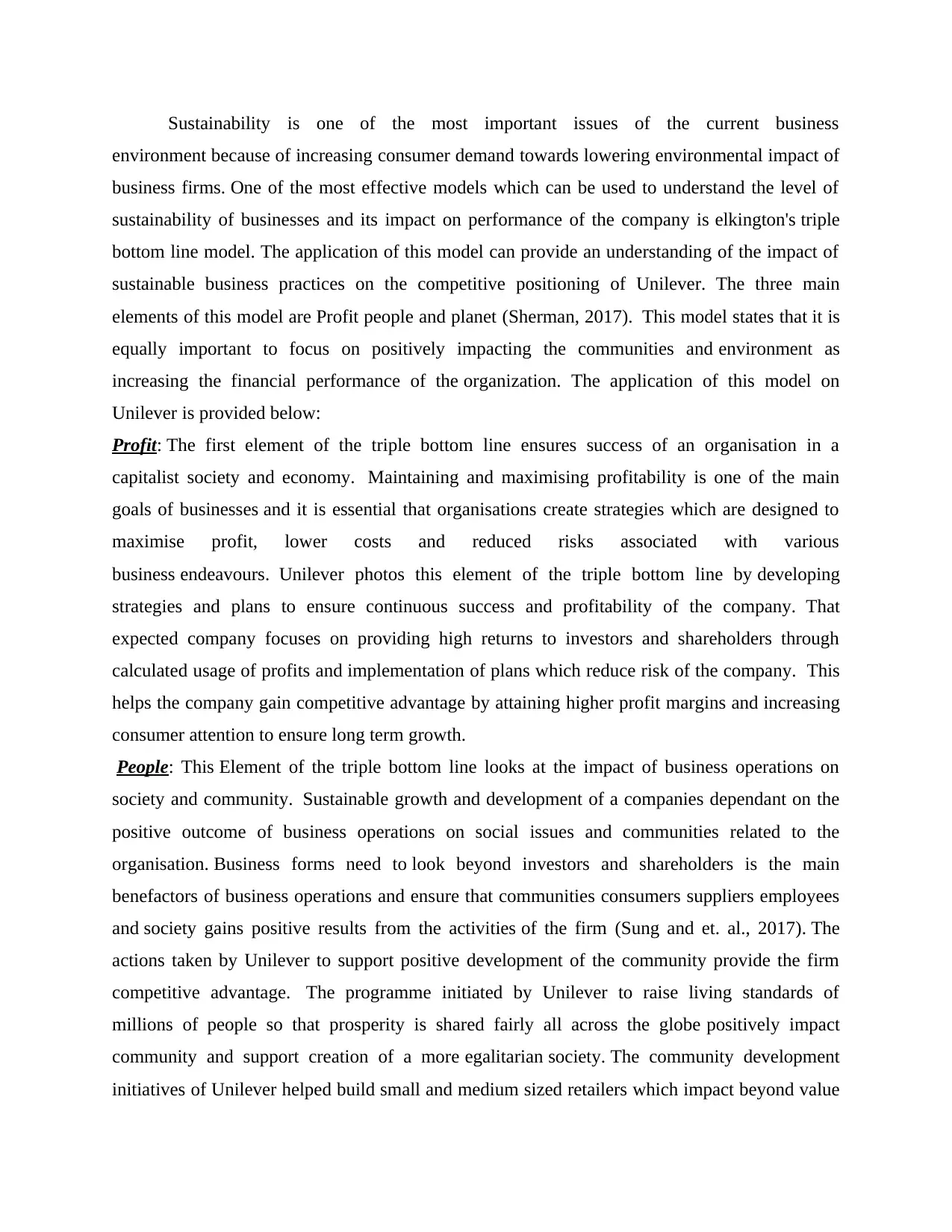
Sustainability is one of the most important issues of the current business
environment because of increasing consumer demand towards lowering environmental impact of
business firms. One of the most effective models which can be used to understand the level of
sustainability of businesses and its impact on performance of the company is elkington's triple
bottom line model. The application of this model can provide an understanding of the impact of
sustainable business practices on the competitive positioning of Unilever. The three main
elements of this model are Profit people and planet (Sherman, 2017). This model states that it is
equally important to focus on positively impacting the communities and environment as
increasing the financial performance of the organization. The application of this model on
Unilever is provided below:
Profit: The first element of the triple bottom line ensures success of an organisation in a
capitalist society and economy. Maintaining and maximising profitability is one of the main
goals of businesses and it is essential that organisations create strategies which are designed to
maximise profit, lower costs and reduced risks associated with various
business endeavours. Unilever photos this element of the triple bottom line by developing
strategies and plans to ensure continuous success and profitability of the company. That
expected company focuses on providing high returns to investors and shareholders through
calculated usage of profits and implementation of plans which reduce risk of the company. This
helps the company gain competitive advantage by attaining higher profit margins and increasing
consumer attention to ensure long term growth.
People: This Element of the triple bottom line looks at the impact of business operations on
society and community. Sustainable growth and development of a companies dependant on the
positive outcome of business operations on social issues and communities related to the
organisation. Business forms need to look beyond investors and shareholders is the main
benefactors of business operations and ensure that communities consumers suppliers employees
and society gains positive results from the activities of the firm (Sung and et. al., 2017). The
actions taken by Unilever to support positive development of the community provide the firm
competitive advantage. The programme initiated by Unilever to raise living standards of
millions of people so that prosperity is shared fairly all across the globe positively impact
community and support creation of a more egalitarian society. The community development
initiatives of Unilever helped build small and medium sized retailers which impact beyond value
environment because of increasing consumer demand towards lowering environmental impact of
business firms. One of the most effective models which can be used to understand the level of
sustainability of businesses and its impact on performance of the company is elkington's triple
bottom line model. The application of this model can provide an understanding of the impact of
sustainable business practices on the competitive positioning of Unilever. The three main
elements of this model are Profit people and planet (Sherman, 2017). This model states that it is
equally important to focus on positively impacting the communities and environment as
increasing the financial performance of the organization. The application of this model on
Unilever is provided below:
Profit: The first element of the triple bottom line ensures success of an organisation in a
capitalist society and economy. Maintaining and maximising profitability is one of the main
goals of businesses and it is essential that organisations create strategies which are designed to
maximise profit, lower costs and reduced risks associated with various
business endeavours. Unilever photos this element of the triple bottom line by developing
strategies and plans to ensure continuous success and profitability of the company. That
expected company focuses on providing high returns to investors and shareholders through
calculated usage of profits and implementation of plans which reduce risk of the company. This
helps the company gain competitive advantage by attaining higher profit margins and increasing
consumer attention to ensure long term growth.
People: This Element of the triple bottom line looks at the impact of business operations on
society and community. Sustainable growth and development of a companies dependant on the
positive outcome of business operations on social issues and communities related to the
organisation. Business forms need to look beyond investors and shareholders is the main
benefactors of business operations and ensure that communities consumers suppliers employees
and society gains positive results from the activities of the firm (Sung and et. al., 2017). The
actions taken by Unilever to support positive development of the community provide the firm
competitive advantage. The programme initiated by Unilever to raise living standards of
millions of people so that prosperity is shared fairly all across the globe positively impact
community and support creation of a more egalitarian society. The community development
initiatives of Unilever helped build small and medium sized retailers which impact beyond value
Paraphrase This Document
Need a fresh take? Get an instant paraphrase of this document with our AI Paraphraser
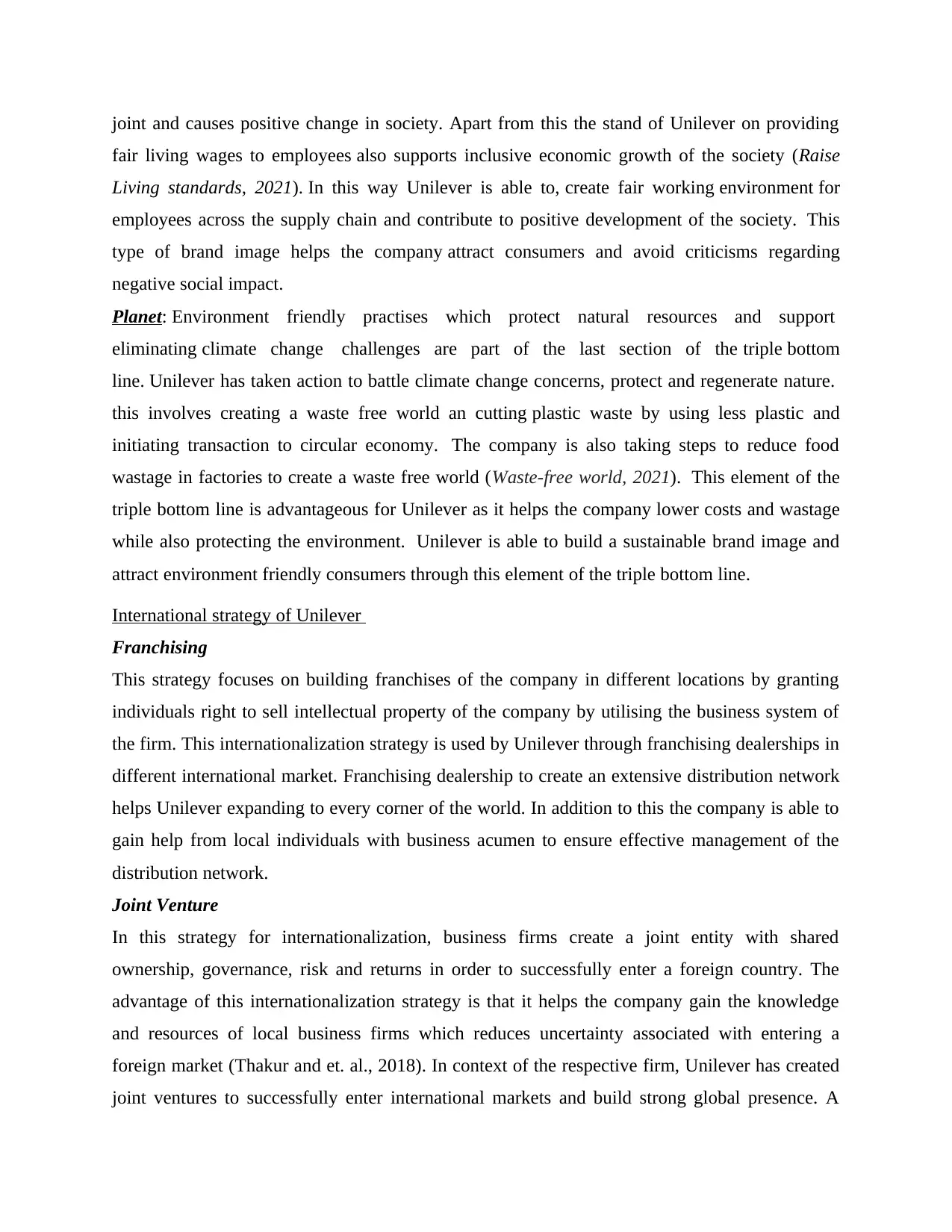
joint and causes positive change in society. Apart from this the stand of Unilever on providing
fair living wages to employees also supports inclusive economic growth of the society (Raise
Living standards, 2021). In this way Unilever is able to, create fair working environment for
employees across the supply chain and contribute to positive development of the society. This
type of brand image helps the company attract consumers and avoid criticisms regarding
negative social impact.
Planet: Environment friendly practises which protect natural resources and support
eliminating climate change challenges are part of the last section of the triple bottom
line. Unilever has taken action to battle climate change concerns, protect and regenerate nature.
this involves creating a waste free world an cutting plastic waste by using less plastic and
initiating transaction to circular economy. The company is also taking steps to reduce food
wastage in factories to create a waste free world (Waste-free world, 2021). This element of the
triple bottom line is advantageous for Unilever as it helps the company lower costs and wastage
while also protecting the environment. Unilever is able to build a sustainable brand image and
attract environment friendly consumers through this element of the triple bottom line.
International strategy of Unilever
Franchising
This strategy focuses on building franchises of the company in different locations by granting
individuals right to sell intellectual property of the company by utilising the business system of
the firm. This internationalization strategy is used by Unilever through franchising dealerships in
different international market. Franchising dealership to create an extensive distribution network
helps Unilever expanding to every corner of the world. In addition to this the company is able to
gain help from local individuals with business acumen to ensure effective management of the
distribution network.
Joint Venture
In this strategy for internationalization, business firms create a joint entity with shared
ownership, governance, risk and returns in order to successfully enter a foreign country. The
advantage of this internationalization strategy is that it helps the company gain the knowledge
and resources of local business firms which reduces uncertainty associated with entering a
foreign market (Thakur and et. al., 2018). In context of the respective firm, Unilever has created
joint ventures to successfully enter international markets and build strong global presence. A
fair living wages to employees also supports inclusive economic growth of the society (Raise
Living standards, 2021). In this way Unilever is able to, create fair working environment for
employees across the supply chain and contribute to positive development of the society. This
type of brand image helps the company attract consumers and avoid criticisms regarding
negative social impact.
Planet: Environment friendly practises which protect natural resources and support
eliminating climate change challenges are part of the last section of the triple bottom
line. Unilever has taken action to battle climate change concerns, protect and regenerate nature.
this involves creating a waste free world an cutting plastic waste by using less plastic and
initiating transaction to circular economy. The company is also taking steps to reduce food
wastage in factories to create a waste free world (Waste-free world, 2021). This element of the
triple bottom line is advantageous for Unilever as it helps the company lower costs and wastage
while also protecting the environment. Unilever is able to build a sustainable brand image and
attract environment friendly consumers through this element of the triple bottom line.
International strategy of Unilever
Franchising
This strategy focuses on building franchises of the company in different locations by granting
individuals right to sell intellectual property of the company by utilising the business system of
the firm. This internationalization strategy is used by Unilever through franchising dealerships in
different international market. Franchising dealership to create an extensive distribution network
helps Unilever expanding to every corner of the world. In addition to this the company is able to
gain help from local individuals with business acumen to ensure effective management of the
distribution network.
Joint Venture
In this strategy for internationalization, business firms create a joint entity with shared
ownership, governance, risk and returns in order to successfully enter a foreign country. The
advantage of this internationalization strategy is that it helps the company gain the knowledge
and resources of local business firms which reduces uncertainty associated with entering a
foreign market (Thakur and et. al., 2018). In context of the respective firm, Unilever has created
joint ventures to successfully enter international markets and build strong global presence. A

recent joint venture introduced by Unilever is with Europe and Asia Commercial Company in
Myanmar (Unilever and EAC announce Joint Venture in Myanmar, 2021). The aim of this joint
venture is to manufacture, market and distribute home and personal care products in Myanmar.
This joint venture will help the respective company create strong presence in Myanmar and
lower risk associated with operating in Myanmar which lacks political stability. In addition to
this, the joint venture will also support long term growth off Unilever in Myanmar.
Business model canvas
This is a strategic tool used to effectively communicate a business concept. The business
model canvas for Unilever is provided below:
Consumer Segment: This involves information about the target consumer base and their
characteristics. In context of Unilever, the firm has multinational presence and offers diverse
products and services in 190 countries. The market segmentation strategy helps the company
deliver quality products to consumers on the basis of their income, their gender and
geographical background. For example the company has introduced perfumes catering to
male consumer segment while dove products with fruity scents are targeted towards female
consumer segments. The focus of Unilever to target different consumers through the diverse
product range of the company helps the firm reach large number of consumers and create
economies of scale.
Consumer Relationship: The ways in which the business firms interact with the consumers
shapes consumer relationship and is the main part of the business model canvas. The
respective company has been able to build strong relationship with consumers through long
history and strong local marketing.
Channels: The primary channels selected for increasing brand awareness about the company are
provided in this section of the business canvas model (Umar, Sasongko and Aguzman,
2018). Unilever utilizes diverse communication strategies to connect with consumers. This
involves traditional channels such as print and TV media along with digital channels such as
social media and email. This helps the company reach vast global consumer base and
maintain stable profitability. .
Key Activities: The actions conducted by the business firms to provide value proposition of the
business concept are included in this element of the business canvas model. The key
activities conducted by Unilever include Human resource management, financial
Myanmar (Unilever and EAC announce Joint Venture in Myanmar, 2021). The aim of this joint
venture is to manufacture, market and distribute home and personal care products in Myanmar.
This joint venture will help the respective company create strong presence in Myanmar and
lower risk associated with operating in Myanmar which lacks political stability. In addition to
this, the joint venture will also support long term growth off Unilever in Myanmar.
Business model canvas
This is a strategic tool used to effectively communicate a business concept. The business
model canvas for Unilever is provided below:
Consumer Segment: This involves information about the target consumer base and their
characteristics. In context of Unilever, the firm has multinational presence and offers diverse
products and services in 190 countries. The market segmentation strategy helps the company
deliver quality products to consumers on the basis of their income, their gender and
geographical background. For example the company has introduced perfumes catering to
male consumer segment while dove products with fruity scents are targeted towards female
consumer segments. The focus of Unilever to target different consumers through the diverse
product range of the company helps the firm reach large number of consumers and create
economies of scale.
Consumer Relationship: The ways in which the business firms interact with the consumers
shapes consumer relationship and is the main part of the business model canvas. The
respective company has been able to build strong relationship with consumers through long
history and strong local marketing.
Channels: The primary channels selected for increasing brand awareness about the company are
provided in this section of the business canvas model (Umar, Sasongko and Aguzman,
2018). Unilever utilizes diverse communication strategies to connect with consumers. This
involves traditional channels such as print and TV media along with digital channels such as
social media and email. This helps the company reach vast global consumer base and
maintain stable profitability. .
Key Activities: The actions conducted by the business firms to provide value proposition of the
business concept are included in this element of the business canvas model. The key
activities conducted by Unilever include Human resource management, financial
⊘ This is a preview!⊘
Do you want full access?
Subscribe today to unlock all pages.

Trusted by 1+ million students worldwide
1 out of 18
Related Documents
Your All-in-One AI-Powered Toolkit for Academic Success.
+13062052269
info@desklib.com
Available 24*7 on WhatsApp / Email
![[object Object]](/_next/static/media/star-bottom.7253800d.svg)
Unlock your academic potential
Copyright © 2020–2025 A2Z Services. All Rights Reserved. Developed and managed by ZUCOL.



